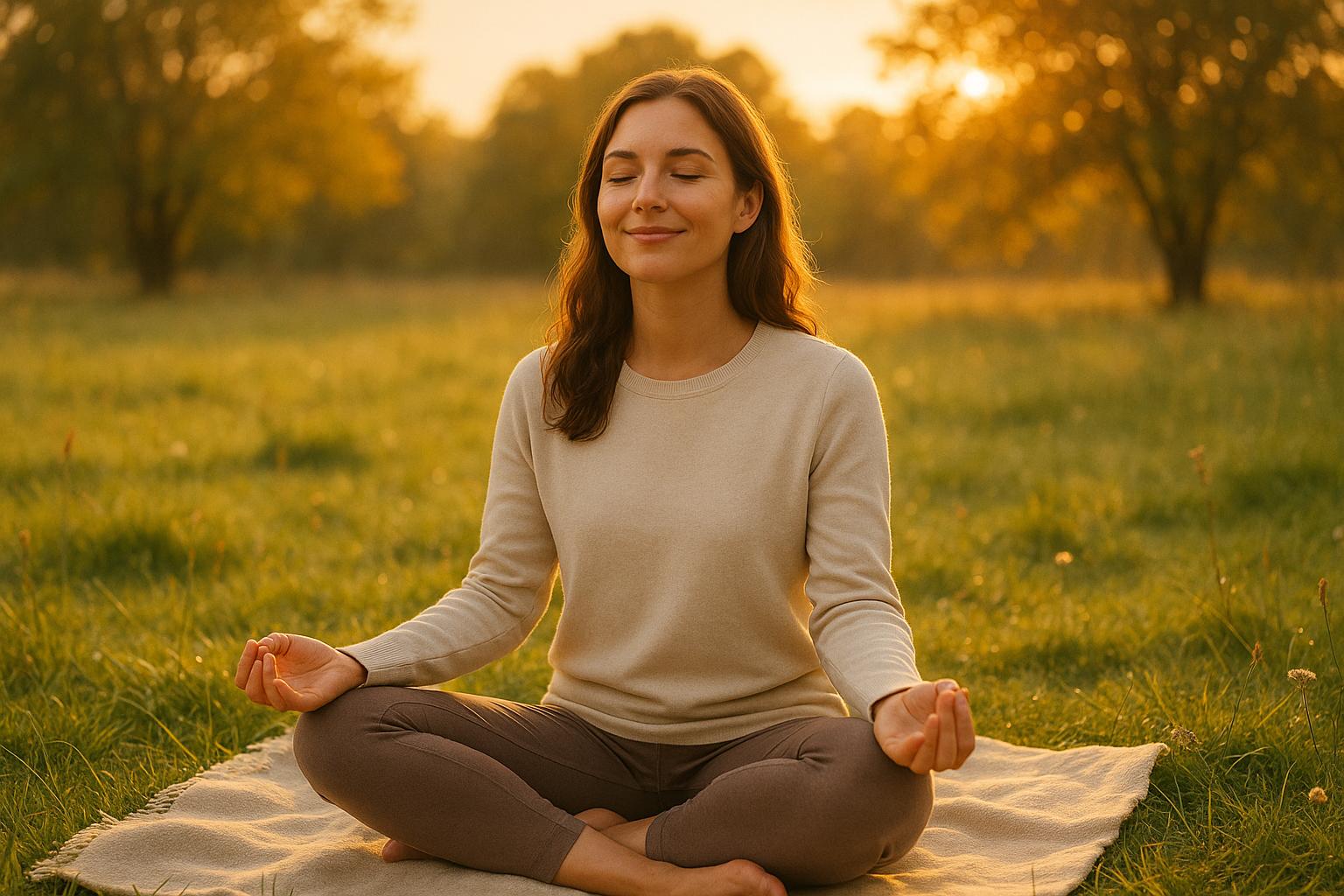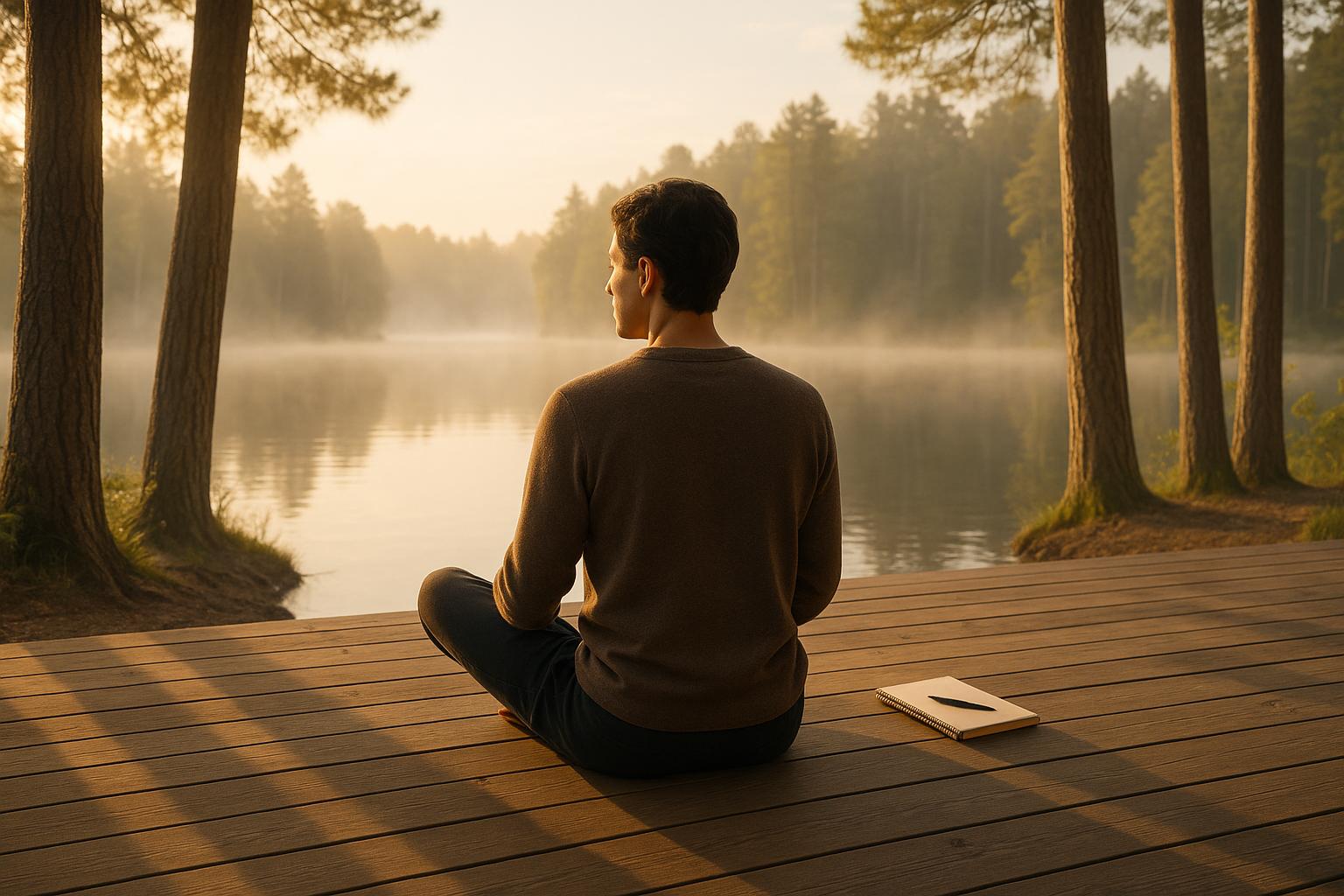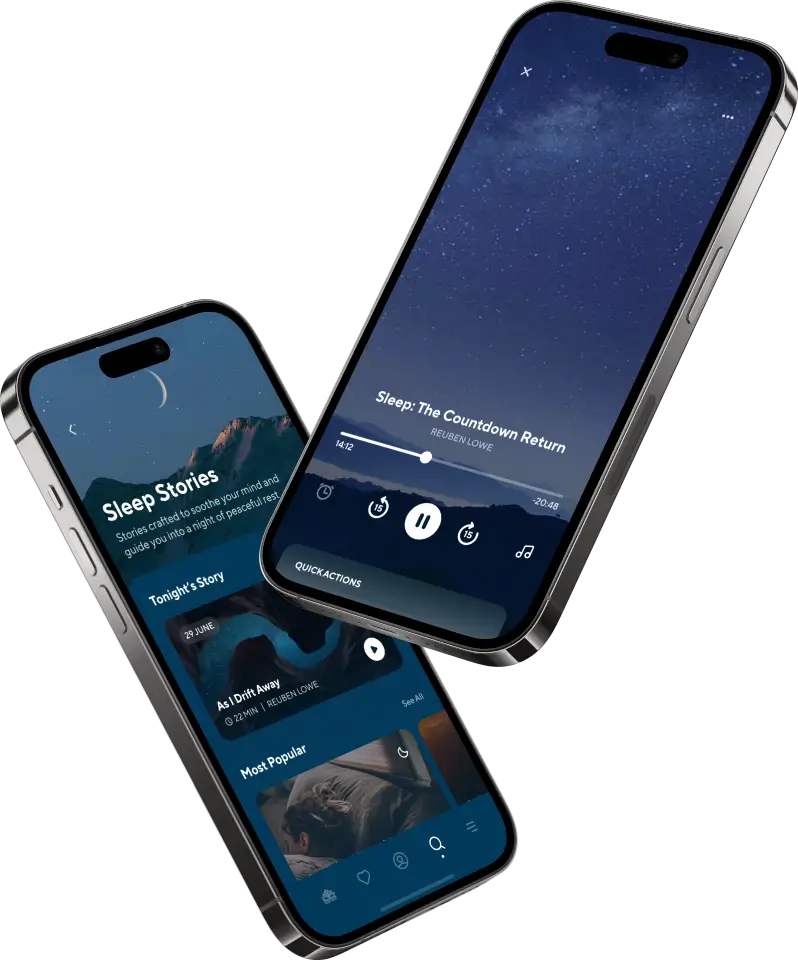Sleep meditation programs are structured practices that help people sleep better by using relaxation techniques like body scans, breathing exercises, and guided imagery. These programs are gaining popularity as more individuals seek non-medication solutions for sleep issues like insomnia and stress. Here’s what makes a successful sleep meditation program:
- Key Techniques: Body scans, progressive muscle relaxation, breath awareness, and visualization are effective methods to promote relaxation.
- Structure Matters: Consistent routines, clear progressions for beginners to advanced users, and predictable session lengths (10-30 minutes) improve adherence and results.
- High-Quality Audio: A soothing voice and clear recordings without background noise enhance the meditation experience.
- Personalization: Offering flexible session lengths, multiple voice options, and diverse content ensures the program meets varied user needs.
- Technology Integration: Apps make these programs accessible, with features like offline access, reminders, and progress tracking to keep users engaged.
Incorporating feedback, working with experts, and maintaining strong privacy practices are also essential for creating effective and trusted meditation programs. These elements help users fall asleep faster, reduce stress, and wake up feeling refreshed.
Sleep Meditation to Calm Your Nervous System and Release Stress | Mindful Movement
Key Elements of Effective Sleep Meditation Programs
Now that we’ve explored the benefits of sleep meditation, let’s dive into what makes a program truly effective. The success of any sleep meditation program hinges on a few critical elements that ensure both engagement and results.
Duration and Session Length
The ideal length for a sleep meditation session typically falls between 10 and 30 minutes. For beginners or those short on time, sessions lasting 10 to 15 minutes can provide a meaningful sense of relaxation through techniques like focused breathing or quick body scans. On the other hand, longer sessions - 20 to 30 minutes - are better suited for individuals facing chronic sleep challenges or high stress, offering deeper relaxation. The key is flexibility: session lengths should adapt to the user’s experience level and schedule, making it easier to integrate meditation into their nightly routine.
Tone, Voice, and Audio Quality
A calming, steady voice is crucial for guiding users into a relaxed state. The narration should be soothing and consistent, avoiding any sudden changes in tone or volume that might disrupt the listener’s journey toward sleep. Many programs rely on professional voice artists or seasoned meditation instructors to achieve this balance. Just as important is the audio quality - recordings should be crystal clear, free from background noise or distortion. High-quality production not only enhances relaxation but also plays a big role in whether users stick with the program. Investing in professional recording equipment pays off by creating an immersive, distraction-free experience.
Meditation Techniques for Sleep
The techniques included in a program should be carefully chosen to support restful sleep. Proven methods like body scans, controlled breathing, and progressive muscle relaxation are particularly effective. These techniques can be offered individually or blended within a single session, allowing users to pick what works best for them. Tailoring these options to the user’s skill level ensures the program remains approachable while still delivering results. By focusing on methods designed specifically for sleep, programs can better meet the diverse needs of their audience.
Step-by-Step Guide to Creating Sleep Meditation Programs
Designing a sleep meditation program that works requires a thoughtful approach centered on your audience. It’s about understanding their needs, choosing the right techniques, and creating high-quality content that genuinely helps people sleep better.
Understanding User Needs
Before diving into production, take the time to learn about your audience. Who are you creating this for? Start by conducting user surveys and interviews to uncover their sleep challenges and preferences. The best programs are built on solid research into what users struggle with, their goals, and how they hope meditation can help.
Take, for example, the 2021 NIH MINDS study. It found that 17 out of 18 participants considered a mindfulness meditation app helpful for improving sleep. Most reported better sleep quality and even broader health benefits. The study also revealed key motivations: users with high adherence (50% or more) were driven by the promise of falling asleep faster, while those with lower adherence struggled with inconsistent routines and work schedules.
Focus groups from the same study highlighted the importance of flexibility and familiar techniques for user satisfaction. Barriers like inconsistent routines and navigation issues were common challenges. Additionally, the study underscored the value of diversity - Black/African American participants, for instance, appreciated having diverse instructors and advocated for more personalized app features.
With these insights, you can build detailed user personas that consider factors like age, stress levels, meditation experience, and specific sleep difficulties such as trouble falling asleep, waking up frequently, or stress-related insomnia. These profiles will guide you in selecting the most effective meditation techniques for your audience.
Choosing Meditation Techniques
Once you’ve identified your audience’s sleep challenges, it’s time to pick the techniques that will work best for them. Segment your users by experience level and specific needs.
- Beginners often benefit from straightforward approaches like breathing exercises or progressive muscle relaxation.
- Experienced users might prefer more advanced techniques like guided imagery or mindfulness-based body scans.
Offering a variety of options is key, but make sure everything remains focused on improving sleep. Popular choices include guided meditations, sleep stories, and structured courses. Techniques like visualization, mindful journaling, breathing exercises, and loving-kindness meditation can all play a role. A good example is The Mindfulness App, which provides over 500 guided meditations and sleep stories in 12 languages. It also allows users to customize session lengths and access expert-led courses designed to tackle sleep and stress.
Consider tailoring meditation tracks to meet different needs. Some users might need help unwinding after a stressful day, while others may struggle to quiet their racing thoughts at bedtime. Reviewing expert advice and analyzing data from existing programs can help you decide which techniques to prioritize.
Writing Scripts and Recording Audio
With your audience’s needs and preferred techniques in mind, the next step is crafting scripts and producing high-quality audio. Scripts should use gentle, soothing language with a slow, deliberate pace and vivid sensory details. Keep sentences short and the tone calming to encourage relaxation and comfort. Adding pauses and prompts for deep breathing can make the experience even more effective.
When it comes to recording, quality matters. Use high-fidelity microphones, eliminate background noise, and ensure consistent volume levels throughout. The audio should be clear and warm, with a neutral or slightly lower-pitched voice. Whether you’re working in a professional studio or a high-quality home setup, aim for a polished result. Ambient sounds like soft rain or gentle music can also enhance the calming effect.
Programs like The Mindfulness App highlight the importance of quality production. With a 4.8/5 rating from over 56,000 users, it’s clear that variety and excellence in content are what users value most. Testimonials frequently mention improved sleep and reduced stress, proving that prioritizing both content and technical quality can lead to success in sleep meditation programs.
sbb-itb-bea8dce
Using Technology for Better Access
Mobile technology has made sleep meditation more accessible than ever, eliminating the constraints of time and location. Thanks to digital platforms, anyone can engage in sleep meditation - whether they're at home, on the road, or juggling a hectic schedule. This shift has paved the way for app-based solutions that prioritize convenience and ease of use.
Delivering Programs Through Mobile Apps
Mobile apps have emerged as a go-to platform for delivering sleep meditation programs. They provide instant access to a wide range of content, including guided meditations, sleep stories, and structured courses. This "on-demand" availability is particularly helpful for individuals with erratic routines, such as night shift workers or frequent travelers crossing time zones.
Take The Mindfulness App, for example. With over 500 exclusive tracks available in 12 languages, it offers a globally accessible solution for sleep meditation. Its mobile-first design allows for scalable, personalized wellness experiences, as reflected in its impressive 4.8/5 rating from more than 56,000 users.
Additionally, features like cross-device syncing and cloud storage ensure users can seamlessly switch between their phone, tablet, or computer without losing their progress or preferences. This continuity reinforces a consistent meditation practice.
Features That Keep Users Engaged
Beyond just providing access, many apps are designed to keep users engaged with features that encourage regular practice. For instance, offline access allows users to download content and meditate even without an internet connection - a lifesaver for travelers or those in areas with limited connectivity.
Other tools, like practice reminders and progress tracking, play a key role in maintaining user engagement. A study by the NIH found that participants with higher adherence rates were motivated by the potential to fall asleep faster, while lower adherence was often tied to mismatched routines. Smart reminder systems that adapt to individual habits can help address these challenges, while visual progress indicators like streaks and session completion metrics provide a sense of achievement, motivating users to stick with their practice.
Apps also enhance the experience by offering personalized recommendations. By analyzing user behavior and feedback, they can suggest session lengths, meditation techniques, or instructors that align with individual preferences.
Customization and Language Options
Language and customization options further expand accessibility. Multi-language support enables users to meditate in their native language, with The Mindfulness App's support for 12 languages serving as a prime example of how localization can reach diverse audiences.
Customizable session lengths cater to different needs, whether someone has just a few minutes or wants a longer, immersive experience. Moreover, incorporating a variety of voices and instructors adds depth to the content. For instance, research has shown that Black/African American participants particularly valued having diverse instructors and advocated for more personalized app features.
The growing demand for such tailored solutions is evident in the global meditation app market, which was valued at $533 million in 2022 and is projected to expand at an impressive 41% CAGR through 2030. This trend highlights the increasing appetite for accessible and personalized mental health and sleep tools.
Best Practices for Quality Sleep Programs
Creating effective sleep meditation programs requires strategies that focus on quality, user safety, and continuous improvement. These principles set professional programs apart and help users achieve better sleep.
Working with Experts
To design effective sleep meditation programs, collaboration with specialists is key. Meditation teachers ensure techniques are grounded in research and fine-tuned for effectiveness. Professional voice artists add calming, high-quality audio that enhances relaxation, while sleep specialists provide scientific insights into sleep cycles, common disorders, and how meditation impacts the brain during the transition to sleep.
Consider forming advisory boards with these experts and scheduling regular content reviews. Joint workshops and training sessions can help maintain high standards and keep your team informed about the latest advancements in sleep science and meditation techniques. These expert contributions allow for continuous refinement of your programs.
Improving Programs Over Time
User feedback plays a critical role in refining sleep meditation programs. For instance, the NIH MINDS study (2021) revealed that 17 out of 18 participants completed a 30-day mindfulness meditation app pilot. Feedback collected through focus groups, daily sleep diaries, and actigraphy sleep tracking showed improvements in falling and staying asleep, while also offering valuable suggestions for program updates. This feedback led to meaningful changes, such as greater personalization and broader instructor representation.
Incorporating sleep tracking data from wearables or app-based trackers can provide deeper insights into user behavior and sleep quality trends. Metrics like session completion rates, user retention, and changes in average sleep duration offer concrete evidence of program effectiveness and highlight areas needing improvement.
Staying current with research is equally important. Regularly reviewing peer-reviewed studies, attending professional conferences, and engaging with experts ensures your programs reflect the latest meditation techniques and sleep hygiene recommendations. Combining user feedback with performance metrics ensures ongoing program evolution.
Privacy and Ethical Standards
Protecting user trust is just as important as delivering quality content. Sleep meditation apps often collect personal data, such as sleep patterns and stress levels, which makes privacy and ethical practices critical.
Ensure compliance with regulations like HIPAA for health data and CCPA for California residents. Use secure methods for storing and transmitting data, and always obtain informed consent before collecting user information. Privacy policies should be written in plain language, making it clear what data is collected, how it’s used, and who has access to it.
Transparency builds trust. Clearly explain your data practices, and provide users with options to view, modify, or delete their information. Avoid designs that encourage unnecessary data sharing. Marketing materials should accurately describe your program’s capabilities without overstating results or promising guaranteed outcomes.
Ethical considerations should also guide app design. Focus on features that genuinely support user well-being, rather than those designed to maximize screen time. Avoid addictive design patterns and emphasize tools that promote healthy sleep habits and mindfulness. If using technologies like AI for personalization, be upfront about how algorithms work and give users control over these settings. Regular audits can ensure new features remain ethical and maintain user trust.
Conclusion: Creating Programs for Better Sleep
Developing effective sleep meditation programs means blending structure, personalization, and technology to help improve sleep quality. Let’s break down why each of these elements plays such a crucial role.
Structure lays the groundwork for consistent practice. Studies, like the MINDS research, show that having a structured routine significantly boosts adherence and leads to better sleep outcomes.
Personalization keeps users engaged over time. Programs that allow users to tailor session lengths, choose from different instructor voices, and select options based on their experience level make meditation more appealing. For example, The Mindfulness App offers a diverse library of customizable content, which has inspired over 6 million users to log more than 180 million mindful minutes globally.
Technology makes quality sleep meditation accessible. Mobile apps allow users to integrate meditation into their busy lives, offering flexibility for evening routines. Features such as offline access, progress tracking, and user-friendly interfaces address common hurdles, helping individuals stick to a regular practice.
When structure, personalization, and technology come together, the result is a program that users can commit to over the long term. Positive feedback from users highlights the impact of these programs on sleep quality. For instance, The Mindfulness App’s 4.8/5 rating from over 56,000 users underscores how thoughtful design translates into real-world results.
The key to designing successful sleep meditation programs lies in understanding that every user’s sleep challenges are different. By combining expert content with flexible, personalized, and accessible delivery, creators can craft programs that not only help people fall asleep faster but also support their mental well-being.
FAQs
How can I create a sleep meditation program that works for my unique needs and schedule?
To create a sleep meditation program tailored to your needs, begin by pinpointing your specific sleep issues and personal preferences. Think about what works best for you: How long should the session be? Do you prefer a soothing voice or minimal guidance? Techniques like deep breathing or body scans might help you unwind - explore what feels most calming.
Building a consistent routine can also make a big difference. Try setting a reminder to meditate at the same time each night, turning it into a peaceful part of your evening ritual. The goal is to shape the program around your lifestyle, ensuring it becomes a relaxing and effective way to prepare for sleep.
What are the advantages of using mobile apps for sleep meditation programs?
Using mobile apps for sleep meditation comes with plenty of perks. They offer quick access to a variety of guided meditations, calming sleep stories, and mindfulness courses, making it easier to stick to a regular meditation practice.
Many of these apps come packed with handy features like personalized suggestions, reminders to keep you on track, and content led by experts. These tools can help ease stress, improve sleep quality, and contribute to a sense of overall well-being. Plus, since you can use them anytime and anywhere, they make weaving mindfulness into your daily routine a breeze.
How do meditation techniques influence the success of a sleep meditation program?
The techniques you use for sleep meditation significantly influence its effectiveness. Methods such as body scans, deep breathing, and progressive relaxation are especially useful for soothing the mind and getting the body ready for rest.
Consistency is key - maintaining a steady tone, duration, and approach focused on relaxation can enhance results. Practicing regularly not only helps you relax but also builds mindfulness, making it easier to stay present and quiet the stress or racing thoughts that often arise at night. Choosing the right techniques can smooth the path to a calm and restful sleep.






